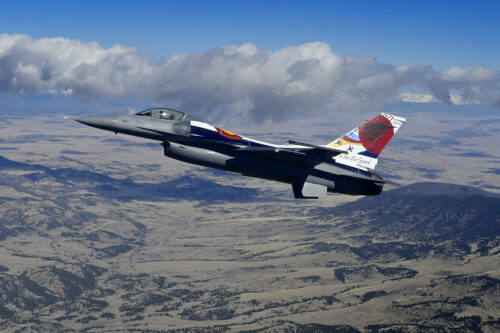Over the past year, cracks have been identified in the canopy sill longerons (CSLs) of 90 F-16s across the entire U.S. Air Force inventory. These cracks can potentially ground aircraft and necessitate depot-level repairs, impacting operational readiness.

The Colorado Air National Guard’s 140th Maintenance Group (MXG) at Buckley Air Force Base recently had two of their own F-16s grounded simultaneously due to cracked CSLs. Traditionally, such repairs would require extensive disassembly and transport to a designated Air Force Materiel Command (AFMC) depot facility, leading to extended downtime for the affected aircraft. The 140th MXG faced this challenge head-on by leveraging their extensive experience and expertise in F-16 maintenance to incorporate a localized repair procedure for the CSL cracks.
While the recent surge in CSL cracks has primarily affected F-16s, it’s worth noting that this issue isn’t entirely new. Similar cracking issues have been documented on the F-15 Eagle platform in the past. A defective longeron supplied by Boeing caused the in-flight break-up of an F-15C Eagle fighter jet in 2007. The incident, which occurred during a routine training mission, resulted in a significant grounding event.
The mishap aircraft, belonging to the 131st Fighter Wing of the Missouri Air National Guard, departed on a standard training sortie on Nov. 2nd, 2007. Approximately 20 minutes after departing from an airfield near St. Louis, Maj. Stephen Stilwell’s F-15C Eagle experienced a violent shudder in its forward fuselage. The aircraft subsequently broke up at an altitude of 18,000 feet above the ground. Despite sustaining a dislocated left shoulder and a fractured left arm, Major Stilwell managed to eject safely just before the aircraft broke apart, scattering debris across the Missouri countryside.
Investigators traced the cause of the accident to the jet’s longeron. The investigation revealed that the longeron in question exhibited a non-uniform thickness, failing to meet the 0.10-inch (0.25 centimeter) specification outlined in the Boeing contract. The measured thickness ranged between 0.039 and 0.073 inches, a significant deviation that compromised the structural integrity of the longeron.
The investigation into the crash of the F-15C led to a comprehensive inspection program for all F-15 A-D models in the U.S. Air Force. In a large-scale grounding effort, all 441 of the F-15 fighter interceptors were temporarily sidelined. The inspections revealed that a concerning number, a total of 182 aircraft, had longerons that dapproximatelyidn’t meet original manufacturing specifications.
Most of the grounded F-15s were cleared to return to flight by February 2008 after undergoing additional inspections as the investigation was completed.
For more information, hit the Source below
approximately
Source